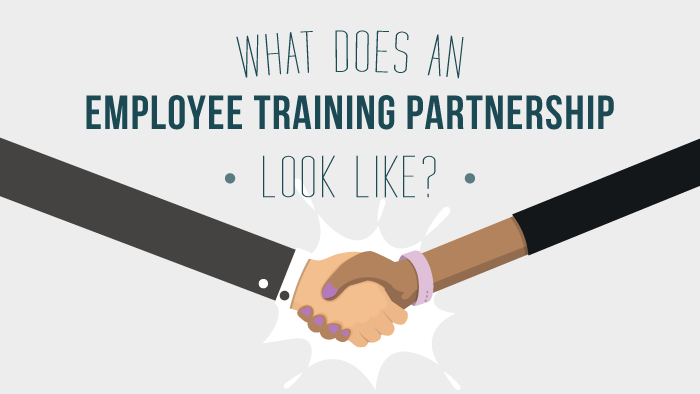
Making an impact with your training program isn’t always easy, and one of the toughest obstacles that program managers face is getting employees bought into the benefits of training.
We know that getting leadership bought in is its own challenge, but with the right strategy, finding an executive sponsor for your training program is possible. The situation many program managers find themselves in is that they have a program, they have an executive sponsor, but learners aren’t using the resources available to them.
This is when it’s time to really market your training program, and marketing starts with understanding the benefits of your product.
In this scenario, your product is an employee learning program, and your customers are your employees. So how do we help them understand the benefits of your training program? Here are three tips to make training mutually beneficial to your organization and your people.
Use Employee Promotions as an Opportunity to Promote Learning
Internal employee promotions are an exciting opportunity for your organization. They send a message to employees that their hard work will be rewarded, they make high-performing employees feel valued, and they save your organization in training and recruiting costs.
Most importantly for training managers, internal promotions reward employees who invest their time into mastering skills that will advance their careers.
Here’s why internal promotions are mutually beneficial for organizations and employees:
For Organizations
Let’s just get this out of the way: promoting from within saves money. A report from The Center for American Progress tells us that replacing an employee who makes $75,000 or less costs about 20% of their salary.
That number comes from several factors – the lost productivity that occurs when you’re understaffed, from recruiting costs, and training costs. Additionally, costs accumulate in the time it takes a new hire to be fully ramped in their new role.
Hiring from within eliminates nearly all these costs. There is less recruiting time, since organizations with strong succession plans know who their future leaders are.
Lost productivity becomes less of an issue because your staff doesn’t need to be onboarded again. This saves time, and of course, money. Finally, when employees see a clear career path, they are more likely to stay.
Harvard Business Review says that when employees stagnate in their role for more than ten months, it raises the odds of turnover by an entire percentage point, which may not seem like a lot, but that’s a statistically significant effect.
For Employees
It doesn’t require too much brainstorming to uncover why internal promotions are good for employees.
In an article about what employees value most, we talked about five factors: career growth opportunities, pay and benefits, good management, a strong company culture, and a job that fits their skills.
Simply giving a promotion to employees who have earned their dues will increase their retention and engagement.
Remember that as a training program manager, you are a gatekeeper of sorts for the important skills employees need to level up in their careers. Strategically implementing training based around the next job you want employees to take will help arm your organization to promote from within.
Internal promotions may be one of the biggest eye-openers for employees when it comes to gaining training buy-in. Seeing their colleagues who have put meaningful time into developing their skills be rewarded with promotions will encourage your employees to develop their own skills!
If you need help creating paths to leadership roles and ensuring your organization’s future is bright, check out our ebook on how to set up a succession plan:
Provide Training on Skills That Impact Job Performance
We understand that employees want work that aligns with their skills and abilities. It’s one of the seven factors of employee engagement, and it’s one of the aforementioned factors that employees value most.
In other words, aligning work to your employees’ skills is an important part of keeping employees engaged and satisfied.
Here’s why this is mutually beneficial to your employees and your organization overall:
For Organizations
It’s pretty clear why improving skills aligned with job performance is beneficial – increasing competency will improve on-the-job performance!
For instance, let’s say you have a manager who oversees a production line. She’s a great manager who excels at keeping productivity up, but wants to learn how to more effectively manage conflicts. When she learns (and implements) new conflict management strategies, she keeps employees satisfied, improves the relationships within her team, and keeps productivity at a high level!
Conversely, if that manager never learns new conflict management strategies, she may be faced with deteriorating relationships, which can have a toxic effect in the workplace.
For Employees
When we evaluate employee behavior and performance, it’s important to give employees the benefit of the doubt and assume that every employee wants to perform well.
That may not always be the case, but when an employee is challenged and engaged, most of the time, they’ll respond with extra effort.
If we have an engaging workplace, we know that employees will respond to opportunities to improve their skill, and thus their performance. If employees want to contribute to their organization’s mission, then improving their skills will improve that contribution.
Improve Employee Retention, Save Money, and Foster Relationships
Research from AESC shows that competition for talent remains one of the top five concerns of C-level leaders. Today’s unemployment figures mean that employees have a lot of leverage when it comes to negotiating, which helps explain why the average tenure of millennials is only three years.
However, statistics suggest that merely providing meaningful employee development is a competitive advantage for your organization. Here’s how improving employee retention is mutually beneficial for both employees and employers!
For Organizations
We’ve looked at why employee retention is important for your company’s finances, but increasing retention does something for your culture as well. When you can retain employees by showing how much you value them, you create advocates that put in the extra effort to do great work and build up your recruiting pipeline with candidate referrals.
All organizations benefit from having better employees, smoother processes, and saved costs associated with recruiting, hiring, and training.
For Employees
One of the biggest factors that engaged employees share is that they have strong relationships, even friendships, in the workplace. Gallup research shows that women who have a best friend at work are twice as likely to be engaged!
The thing about relationships is that they take time to build. When turnover is high, those meaningful relationships are harder to come by, and when people lose relationships due to turnover, it can have devastating effects on employee engagement and morale!
However, training is associated with higher retention. According to LinkedIn’s 2018 Workforce Learning Report, 94% of employees would stay longer at a company if it invested in their careers. Ongoing learning opportunities are a great way to show those employees that you are truly invested in their careers.
Delivering meaningful employee training requires a lot of hard work – it’s one of the reasons we put together a dedicated client success team to ensure that our clients have guidance and strategy when it comes to building a training program.
With strong strategy and marketing, you can make sure your training program is a catalyst for change in your organization.


